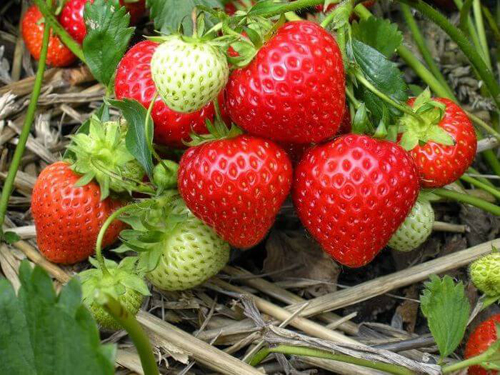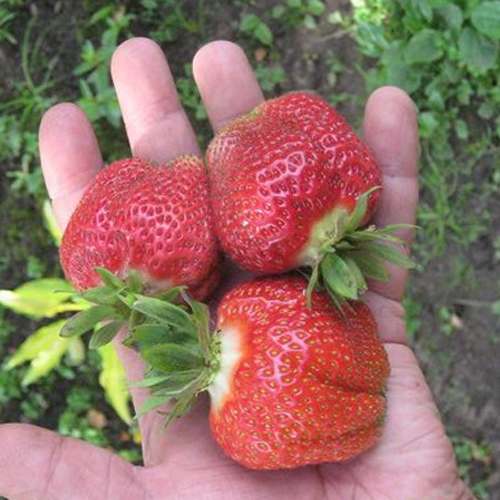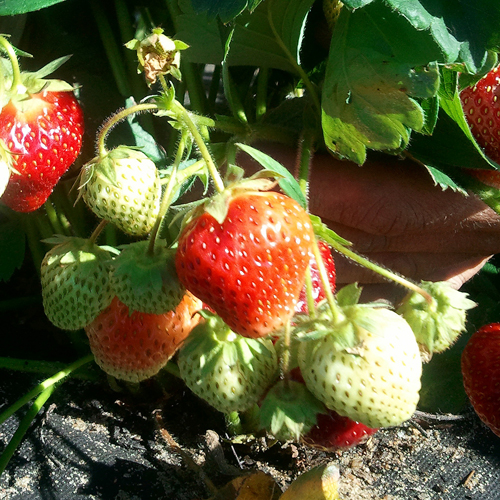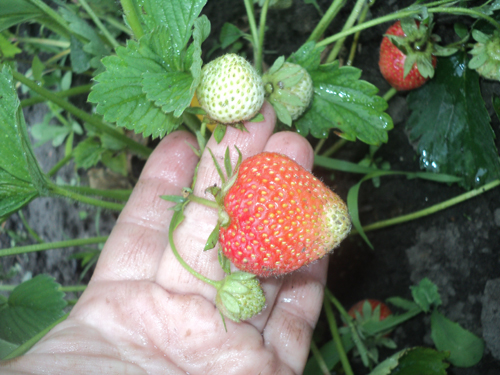Kent strawberry variety
Kent is a non-repairable variety of early ripening strawberries. It was bred in 1973 in the city of Kentville by employees of the Canadian Research Station. The pedigree contains the Redgauntlet, Tioga and Raritan varieties. In 1974, the breeders finally fixed the varietal characteristics of the plant, and since 1978 the novelty has begun to undergo large-scale trials. Three years later, in 1981, the strawberry was officially registered and began to be actively distributed in various countries. It is appreciated for its good yield, early ripening, excellent presentation of berries and their excellent taste. Suitable for growing both outdoors and indoors. Suitable for cultivation in regions with a rather cold climate.

The plant is tall and powerful, erect, spreading. The whiskers form a medium or large number. The leaves are large, dark green in color, on long petioles. Peduncles are long, and are laid on the ground under the weight of the berries. In the first year of fruiting, Kent forms quite a few peduncles (about 5), in the next more (10-15).
Berries are medium in size, round-conical in shape. A feature of the variety is the presence of a small tubercle, and sometimes several, in the neck of the fruit. The neck itself is very short or absent. Achenes are yellow, superficial. The skin is bright red, shiny. The flesh of the strawberry is red, very firm, but without apple crunch on the bite, juicy and aromatic. The berries are easily separated from the stalk, the sepal breaks off to a medium degree.

The taste of the fruit is very sweet, with a moderate, unobtrusive sourness. The taste of Kent is superior to many other early maturing varieties. Due to the dense pulp, the berries tolerate transportation well, have an excellent presentation and will attract the attention of buyers on the market. There is, however, one nuance - a tubercle characteristic of the variety in the neck of the berry can sometimes be too pronounced, giving the fruit a very bizarre look. However, this is an isolated phenomenon and will not cause problems commercially. Strawberries are versatile in use, great fresh, suitable for all kinds of processing, as well as for storage in frozen form and whole-fruit canning.
The average weight of berries at the first harvest is about 30 grams, some specimens reach a weight of 40 grams or more. In subsequent harvests, the fruits become much smaller, which, by the way, is the main drawback of Kent, and their weight can decrease to about 15 grams, or even less. The fruiting itself in our hero is quite extended, it begins around the middle of May, along with Honey... According to the results of tests of the variety in his homeland, the yield averaged about 17-18 tons per hectare. According to the nurseries, it is possible to harvest from 0.7 kg of berries from one plant. Unfortunately, such numbers cannot be called large, and we can say that Kent is significantly inferior to other modern varieties. Many large agricultural firms and farmers abandoned these strawberries in favor of other, more productive ones.

Plants are highly resistant to gray mold, powdery mildew, various leaf spots, and also confidently resist strawberry mites. The variety is susceptible to verticillary wilt, but with timely prevention this will not be a problem. One of the main advantages of this strawberry is its excellent winter hardiness. Even in frosty winters with little snow, plants are able to survive. In the conditions of some regions of Russia, this feature of Kent can be a huge plus, because while other varieties often cannot withstand the harsh climatic conditions, our hero feels completely normal and pleases with an annual stable harvest. In addition, the plants are also frost-resistant, calmly tolerate spring return frosts. However, it is better to take care of the cover of the plantings so as not to risk it.
Another big plus of this strawberry is that it is shade-tolerant.You can confidently plant it in a shaded area and not be afraid for the taste of the berries. As for drought tolerance, we can say the following: drought will not adversely affect plants, but yields can be seriously affected. But the variety treats waterlogging of the soil absolutely calmly. In rainy seasons, you don't have to worry about the taste of the berries - they will remain at their best. The only thing is that the risk of contracting fungal diseases increases, but this problem can be easily solved with preventive measures.

In agricultural technology, Kent is absolutely simple, very unpretentious and does not require the creation of special conditions. Moreover, it thrives on a wide variety of soils. Strawberries need the most minimal care, which is especially convenient for those who visit their site only on weekends. Timely watering, loosening the soil, weeding, feeding as needed - that's all the trouble. It is worth saying that the variety is very appreciated for its unpretentiousness, it is thanks to this quality that many gardeners do not refuse it. While modern varieties constantly require attention, Kent can be, as they say, just "plant and forget." Of course, plants will respond very well to all your efforts and reward you with a more generous harvest.
Of the agrotechnical nuances, only a couple of important points should be highlighted. Plants should be planted according to the 50 × 50 cm scheme. A more compacted planting is undesirable, since the bushes are very powerful and spreading, and they will literally be cramped. In addition, the root system of strawberries will suffer from a lack of nutrition, and the risk of disease will increase. The second nuance is that it is extremely important to timely rejuvenate the plantation. Some sources recommend doing this every 3-4 years, however, according to gardeners, Kent shows the best yield only in the first two years of cultivation, in the third it is already much less.

What I would like to say at the end. This variety, tested by time and experience, certainly deserves attention. But, unfortunately, it is now considered obsolete, and it really is. First, it falls short of the favorites of the strawberry market in terms of yield. Secondly, the breeders are not asleep, and our hero can no longer "knock out" a place for himself on the site only because of his good taste - there are varieties that are more tasty. Thirdly, Kent has a very unstable fruiting, after the second harvest, the crop will no longer please you - there will be one trifle on the bushes that you don't want to collect. If there are other varieties on the market, including remontant varieties, capable of forming large fruits all season, this nuance has become almost fatal for our hero. It is because of this shortcoming that not only farmers and agricultural firms, but also ordinary gardeners, abandoned its cultivation.
But despite such a list of disadvantages, the variety has outstanding advantages. The main one is that this strawberry can be grown in a wide variety of climatic conditions. Where those very modern "giants" of the strawberry market simply do not survive, Kent shows stable good results and feels great. Another big plus is ease of maintenance, which is often very important for gardeners. Our hero does not require abundant feeding and "dancing with a tambourine", which are indispensable when growing many popular high-yielding varieties. In general, if you live in a region with a difficult climate or you simply do not have time to take care of the plantings, then this strawberry is an excellent solution. And if you want something very tasty and high-yielding, then it is better to pay attention to other varieties, fortunately, now there are plenty to choose from.








